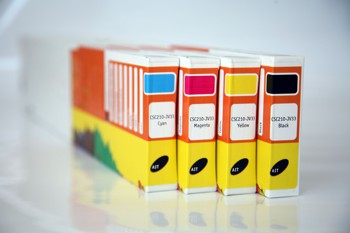Applied Image
Roger Ward, AIT Shiraz Ltd, reveals that “green inks” as well as the printers in which they are used have come a long way in recent years, so much so that there has been a notable shift in the demands from clients.
“Traditionally our customers have opted for solvent printers, but many have since migrated to latex machines, no doubt influenced by the arguments about inks with low odour, an ability to print onto a wider range of textile substrates, no need for outgassing, vibrant colours, lower machine maintenance and ostensibly, a greener “water-based” product,” says Roger. But like many, he is quick to point out that the benefits of latex inks with green credentials can be counteracted by the printing machines that use more heat and power to dry the finished prints. “I would advise sign makers to select a machine that is best suited for the end-user’s main market,” he says.
 AIT Shiraz Ltd, based in Kings Hill, Kent, offers a range of ColorSolve solvent inks, suitable for use with printers such as the Mimaki JV3 and JV33. The prints produced with this ink are comparative with those created using OEM inks, something Roger attributes to the high standard of manufacture. “ColorSolve inks are manufactured in Europe to ISO 9001 standards and have been successfully used at over 200 sites in the UK. They are colour matched to the OEM inks and can be swapped as the originals expire.”
AIT Shiraz Ltd, based in Kings Hill, Kent, offers a range of ColorSolve solvent inks, suitable for use with printers such as the Mimaki JV3 and JV33. The prints produced with this ink are comparative with those created using OEM inks, something Roger attributes to the high standard of manufacture. “ColorSolve inks are manufactured in Europe to ISO 9001 standards and have been successfully used at over 200 sites in the UK. They are colour matched to the OEM inks and can be swapped as the originals expire.”
Indeed, AIT’s ColorSolve inks have proved to be powerful alternatives to OEM inks, as they can reduce ink costs by up to 40%. AIT also provides excellent after-sales care, offering field service support and genuine replacement parts at the half the cost. Spare parts, online ordering and support from UK-based engineers have also contributed to the demand for ColorSolveproducts from AIT Shiraz in recent years.
Helping sign makers keep costs low
Roger adds that there have been a number of advances in solvent technology in terms of odour and safety, and although there is a rise in the demand for environmentally-friendly inks, the market for traditional solvent inks will continue to remain strong as retired machines exchange hands to new users who seek both minimal capital outlay and lower on-going overheads.
“The printing community needs to reduce their costs to stay competitive and I believe we can help them with our range of products and services,” he says. When it comes to reducing the cost of prints without jeopardizing the finished product, OEM inks could rapidly become a thing of the past. “Sensible use of third party solvent inks can help keep costs to a minimum,” says Roger.
For more information visit www.applied-image.com.
